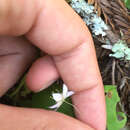en
names in breadcrumbs


The Pacific starflower (Trientalis latifolia), also known as Trientalis borealis, is a perennial herb in the Primulaceae family that typically blooms between the months of March and July. Five petals sprout from a thin stalk that is usually 17 cm in height. The stalk grows from the center of 4-8 oval leaves. These petals are generally white or pale pink, and are teardrop shaped with a thin, pointed tip. Five to seven yellow stamens protrude from the center of the flower (Alden 1998). T. latifolia becomes dormant in midsummer, when its leaves wilt and turn yellow. Throughout the winter, a stem remains with one or two seed capsules at its tip. The seeds do not germinate until the fall of their second year so that they can be dispersed by various animals.
Trientalis latifolia is native to the west and northwest United States including California, Oregon, Washington, and Idaho. It also is commonly found in the Western Canadian province of British Columbia (USDA 2017). It lives mostly west of the Cascade Mountain range in coniferous forests and other moist areas such as stream banks and ocean cliffs, as well as on mid-elevation prairies (Flora of North America 2017). It grows best in slightly acidic, highly nutrient dense soils that are present in many such forests and prairies.
Bees are the main pollinators of this angiosperm, as well as other small insects (Stritch 2017). There is currently no concern for the conservation of T. latifolia. If its main pollinator, the bee, becomes less abundant, however, concern for conservation may heighten. It is very abundant and easy to grow, however never invasive. The flower is edible and is often used for cooking purposes and oil.
Lysimachia latifolia, sometimes called Trientalis latifolia, is a species of flowering plant in the family Primulaceae.[1][2][3][4] It is known as starflower,[3][4][5] chickweed-wintergreen,[5] or Pacific starflower.[6]
It is a low-growing, creeping perennial[5][7] reaching (5 to 30 cm (2.0 to 11.8 in)).[8] The roots are tuberous,[5][7] creeping rhizomes.[7] The stems are erect,[7] 10–20 cm (4–8 in) high.[5] It has 5 to 7 whorled, lanceolate, entire leaves distributed levelly in a single group.[7]
The flowers are white[5][7] or pink[5] flowers are borne in April[5] or May.[5][7] Calyx (the collective term for sepals) is 5- to 9-parted and persistent. Corolla (the collective term for petals) is also 5- to 9-parted, rotate,[5][7] with a very short tube[7] and elliptic-lanceolate segments. Stamens occur in the same number as the corolla lobes (5-9)[5][7] and are positioned opposite them.[5] 1-3 peduncles, 1-flowered, filiform, and ebracteate.[7] The ovary is one-celled. The style (gynoecium) is filiform.[5]
Occurs on moist, shaded[3][7] slopes in deep,[3] light[7] soil rich in organic matter,[3][7] particularly leaf mould.[7]
The former genus name Trientalis is derived from the Latin triens ('a third'), and is an allusion to the height of the plant, which is one third of a foot, or 4 in (10 cm) high.[5][10] Latifolia is derived from the Latin words latus ('broad or wide') and folia ('leaves') and means approximately 'broad-leaved'.[10]
The alternative name "Indian potato" refers to a small subterranean swelling at the stem's base, which is not listed as being edible by modern sources.[11]
Lysimachia latifolia, sometimes called Trientalis latifolia, is a species of flowering plant in the family Primulaceae. It is known as starflower, chickweed-wintergreen, or Pacific starflower.